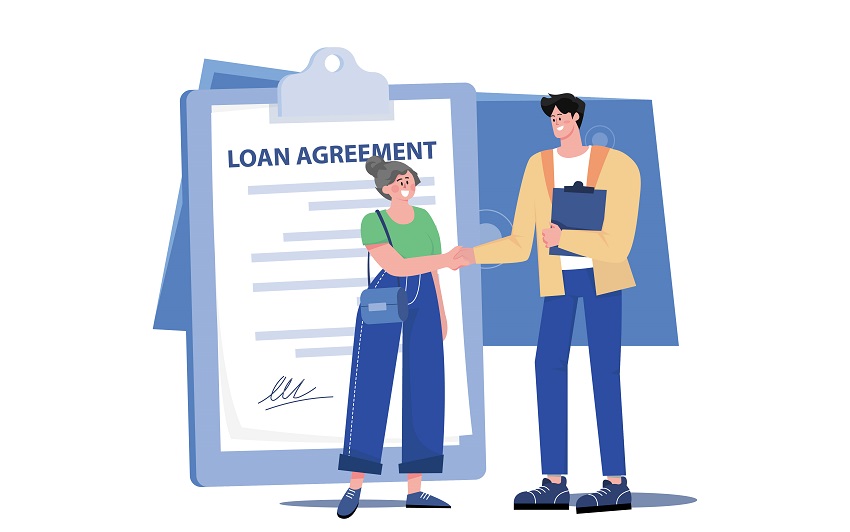

Did You Know?
We serve loans, the best way you can borrow

We serve loans, the best way you can borrow

A personal loan agreement is a legal document that protects both the borrower and the lender. Many people face disputes over money because they skip this step. The agreement sets clear rules about loan amount, interest rate, and payment dates.
Banks and financial companies always use these documents to avoid confusion. Smart borrowers create written agreements even with close friends. It protects relationships while preventing financial arguments. The document becomes proof if legal issues arise later.
Every loan agreement needs specific details to work properly.
1. Dates: Important dates when the contract starts and any other key deadline dates.
2. Identifications: The contract lists the names of all people involved and their complete addresses.
3. Interest Rate: The cost of borrowing money may be fixed or variable throughout the loan period.
4. Collateral: The asset is used to secure the loan if the borrower owns the relevant property.
5. Loan Amount: The principal amount the borrower agrees to take out from the lender party.
6. Repayment Schedule: Plan outlining when and how much the borrower needs to repay the loan.
7. Jurisdiction: Area where the court's decision can apply if legal disputes arise between parties.
8. Severability Clause: Ensures the remaining contract stays legal even if one portion becomes invalid or unenforceable.
9. Penalties: Consequences of not paying loans on time, including what happens during default situations.
10. Signature: Both lender and borrower must sign the agreement document to seal the deal.
11. Entire Agreement Clause: Defines the complete scope of the agreement and states nothing outside the contract applies here.
Different fees apply throughout the loan process and repayment period.
1. Processing Fees: Banks charge 1-5% of the loan amount for application processing and document verification.
2. Late Payment Charges: Extra fees when borrowers miss due dates, typically 2-4% per month.
3. Prepayment Fees: Some lenders charge 2-5% when borrowers repay loans early before maturity.
Clear understanding prevents conflicts while ensuring smooth loan processing throughout the agreement period.
Borrowers must repay on time while maintaining good financial standing. They should also inform lenders about income changes impacting the repayment capacity.
Lenders provide funds as agreed while maintaining transparent communication. In addition, they must follow fair collection practices without harassment.
Both the parties must respect the terms of the agreement. They must communicate openly about any payment difficulties or changes.
Creating a personal loan agreement protects everyone involved. It prevents future disputes as well. Start with basic information and add specific terms. Include all important details to avoid confusion later.
1. Write Basic Information: Include the full names & addresses (also phone numbers) of both borrowers and lenders. Do not forget to add the current date alongside when you sign the agreement.
2. State Loan Amount and Purpose: Write the amount in numbers & words. You should also mention what the borrower will use the money for (like medical bills or education expenses).
3. Set Interest Rate and Fees: Decide on the annual interest rate as well as processing fees. Also, you should ensure both agree on these charges before writing this agreement.
4. Create a Payment Schedule: List monthly payment amounts, due dates, and total number of payments. Include where and how the borrower will make payments regularly.
5. Add Default Terms: Explain what happens when the borrower misses payments. Do they break agreement rules? Include late fees and collection procedures for such situations.
6. Include Signatures: Both should sign & give proper dates in the agreement. Consider having a witness sign to make the document more legally binding.
Professional lenders always include certain terms to protect their interests while ensuring loan recovery.
1. Force Majeure: It gives the lender permission to alter interest rates based on extraordinary economic circumstances.
2. Fluctuation of Interest: This clause gives banks permission to change interest rates based on fluctuations.
3. Default Definition: This states what qualifies as default on the loan after missed payments.
4. Security Cover: It outlines assets being offered as security for secured loans like property purchases.
5. Disbursement: This clause clarifies where the borrowed money is sent properly.
6. Other Balances Offset: It outlines how payments will be offset by other balances owed between parties.
7. Reset: This clause defines if and when interest rates will be revisited and reset later.
8. Amendment: It gives the lender the right to amend any clause without informing the borrower.
9. Third-party Repayment Collection: This clause claims the lender's right to hire third parties to collect outstanding payments.
10. Severability: Proclaims that one void provision will not affect the validity of other provisions.
11. Notification: Specifies life events that the borrower must inform the lender about, like income changes.
12. Assignment Rights: Allows lenders to transfer loan agreements to other financial institutions or investors.
This loan application letter is made and entered into as of March 10, 2025, by and between:
Lender – Rik Verma with an address at 23 Sector 15, Noida, Uttar Pradesh 201301
Borrower – Juhi Gupta, with an address at 67 Model Town, Delhi 110009
Loan amount & terms
The lender offers the principal amount (for instance, ₹1,00,000). The borrower must repay the complete loan, including accumulated interest, by March 10, 2026.
Interest rate
This loan carries interest at 15% annually, computed on the remaining principal balance from this agreement date until complete loan repayment.
Repayment
The borrower will repay through monthly payments of ₹9,500, payable on the 10th day of each month from April 10, 2025, until March 10, 2026.
Prepayment
The borrower may repay the entire loan or partial amounts anytime without any extra charges. Paying early applies first to accumulated interest & then to the principal balance.
Default
The lender may demand immediate payment of the remaining principal in addition to the interest when the borrower misses scheduled payments. The borrower covers the collection costs as well as legal fees incurred by the lender in the agreement.
Governing law
This contract follows and gets interpreted according to Delhi state legal regulations and statutes.
Amendments
Any changes made to the contract need written documentation with signatures from both.
Signatures
Both borrower and lender must give written signatures to make this loan agreement legally binding.
Borrower Signature: …. Date: …..
Lender Signature: …. Date: ….
So, the personal loan agreement sample shows how proper documentation protects both during the whole lending process.
A promissory note is the one that one party promises. It is simpler and contains detailed information about paying the amount to the other within the agreed term. A personal loan agreement template is a contract that includes detailed terms, payment schedules, and legal protections.
People use loan agreements for medical bills, education expenses, wedding costs, and emergency situations. The personal loan agreement format in Word India covers home repairs, business startup costs, and debt consolidation needs. Borrowers can fund vacations, buy vehicles, or handle unexpected financial crises. Any legitimate personal expense qualifies for loan agreement coverage.
Yes, properly written and signed loan agreements become legally enforceable documents in Indian courts. Both parties must understand the terms and sign voluntarily without pressure or fraud. The stamp duty on personal loan agreement varies by state.
Notarisation is not mandatory for personal loan agreements in India but adds legal security and authenticity. Banks and financial institutions often require notarised documents for larger amounts. A personal loan agreement form becomes stronger evidence in court when notarised by authorised officials. Consider notarisation for loans above ₹ 1 lakh.
Loan agreements can be cancelled through mutual consent of both borrower and lender parties. Legal grounds include fraud or misrepresentation during agreement creation. A simple personal loan agreement should include cancellation procedures and any applicable fees. Courts may void agreements that violate consumer protection laws or contain illegal terms.
Written agreements prevent memory disputes while offering clear evidence of loan terms as well as conditions. A simple personal loan agreement protects relationships by eliminating confusion about payment dates & interest rates. Verbal agreements become difficult to prove in court. It may result in breaking friendships over financial disputes.
Start with basic information & then add the loan amount. Don't forget to include interest rate as well as repayment schedule details. Include late payment penalties & default conditions. Ensure you add the collection procedures in simple language. A standard personal loan agreement should cover all possible scenarios, such as – early repayment, loan modifications, dispute resolution methods, etc., for complete protection.
Download our personal loan app to apply for a personal loan. Get up to 2Lakhs* as a personal loan. Download Now!
Sign into avail a personal loan up to ₹ 2,50,000
Register to avail an instant loan in just a few minutes. Fulfil your financial needs with our loan and repay in easy EMIs.
Apply NowUnifinz Capital India Limited is a Non Banking Finance Company (NBFC) registered with the Reserve Bank of India (RBI). lendingplate is the brand name under which the company conducts its lending operations and specialises in meeting customer’s instant financial needs.
Corporate Identity No. (CIN)
L 1 7 1 1 1 D L 1 9 8 2 P L C 0 1 3 7 9 0
RBI Certificate of Registration No (CoR):
1 4 . 0 0 2 3 3
Registered Office :
Rajlok Building (Floor-5), 24 Nehru Place, New Delhi-110 019